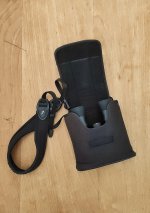(I wasn’t sure whether to open a new thread, or simply write impressions in an already existing review thread about the binoculars. I was afraid of duplicating and creating a lot of "noise", so I’m writing here hoping not to upset the OP (or hijacking the thread), but contributing to the share knowledge/experience base that this forum is, and concentrate it in one place. Should it be out of place here, I’m happy to delete it from here and open a new thread).
After one year of pretty intense use of a Canon IS III 12x36 (with its ups and downs,
that I explained here) and after the positive reviews by several forum members, like Canip, or Neil here, I've decided to try the smallest Canon IS, which in theory should make up for three of the biggest drawbacks I found on the 12x36: size/weight, image quality and close focus. I received them a couple of days ago and I can’t speak a lot about the optical performance yet, but here are a few impressions about the shape, size and handling, with some pictures that I hope can help put the Canon IS 8x20 in context.
Although the Canon are 8x20, because of their size and weight I think 8x32 are their natural rivals. So here it is compared to a very compact 8x32, the Opticron Traveller ED and a largish 8x32, Swarovski EL (well, dwarfed by Zeiss’s latest SF 8x32).
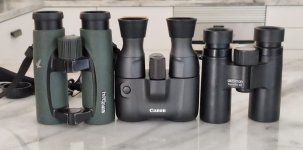
The Canon are 430 g on my scale (including batteries), which is lighter than the pretty light Traveller (at 450 g). However, the Canon are surprisingly thick, more than I anticipated, so this makes them feel less nimble (which is something I really appreciate in 8x32/30; the fact that they don’t weight much, the barrels are thinner than 42x and are so easy to grab, even singlehand).
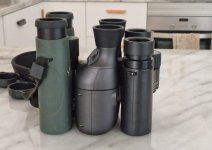
As a matter of fact, when I compared them to my 12x36 IS III I was in for a small shock, because the barrels of the 8x20 feel at least as thick, if not thicker, than those in the 12x36. I did a very simple test. I lied both flat on the kitchen counter and put a leveled book on top of the two… and the 8x20 is the thickest! If you look at the picture below in detail, you can see that there is a 1 or 2 mm gap between the 12x36 and the book (while the book is resting on top of the 8x20).
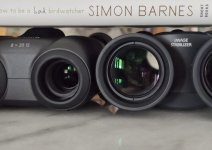
I was a bit underwhelmed by this. They are shorter than the 12x36, but probably not as much as I anticipated by reading the specs and watching pictures and videos.
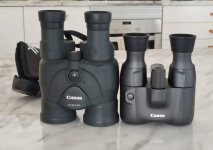
It is still too soon to know how I’ll get on with these, but size-bulk and weight are a crucial asset of the 8x32 breed for me (probably the reason I don’t think I’ll ever have an 8x32 SF, even if I could afford it, nor an 8x32 Nikon EDG), so their sheer thickness doesn’t look very promising.
First glances through the 8x20 confirm that the perceived image quality is higher compared to the 12x36 IS III. They look sharper (the 12x36 offer a somewhat soft image compared to say an EL, or even less expensive devices), and CA is minimal, even under high-contrast and bright light conditions. Close focus is probably less than the specified 2 m (but I find I have to change the IPD to get a comfortable view). All these are 3 of the things that I was looking to improve upon the 12x36, and the little Canon seems to deliver. So far so good.
Then it comes the "dreaded small exit pupil" issue. As I experienced recently with the super comfy 7x20 reverse Porro Nikon 7x20 CF III, in my case I've discover that the finicky eye position, the low levels os user-friendlyness and general "less than stellar" experience with 8x20 and some 8x25 double hinge models was not the size of the exit pupil, but the size of the eyecups, and the use of a single hinge. Yes, this probably are not as easy and fast to use as some 8x32 (yet, I find huge differences between some 8x32, the EL being my favourite, basically I find they work like an 8x42, so easy to find the right position and never an issue with blackouts), but the 8x20 are just a "regular" pair of binoculars: there are more comfortable binoculars and there are less. For example, I'd say I find them more comfortable and offering a bigger "ease of use and eyecup comfort" than a 7x35 Retrovid or a 8x32 Meopta Meostar to name two great binoculars that I simply can't use due to ridiculously narrow eyecups. It was not the exit pupil: it was the eyecups (and double hinge, in the case of some great 8x20 like Leica Ultravid or Swarovski Habicht, that I found basically unusable for me). This has been quite a discovery for me: I found it in the 7x20 Nikon and confirmed it with the Canon.
I’ll be using them over the next weeks to have a better feel of what it's capable of. As for today (mind you, just two days of use, so I’m writing this here more as a personal note for reference than a serious statement), I’ve compared them with other 8x and found the image a bit dark (to my surprise). Today I’ve done a back to back test with two very different and distinct flavours of 8x: a huge 8x56 with AK prisms, the Vixen New Foresta, and a Swarovski EL SV 8x32. In broad daylight (around noon, month of May, Mediterranean sun, hardly any cloud in the sky), looking at the almond tree in the garden, where greenfinches and flycatchers like to linger, both the bark and the leaves looked noticeably brighter through the Vixen (unexpected, I would have assumed the Canon would beat the Vixen on daylight brightness) and the EL (well, that was expected, given the price difference). At first I thought it could be the relatively narrow FOV, but looking at different areas exposed to sunlight/shadows, the Canon offered a distinct less bright view to my eyes. In terms of contrast and sharpness, actually very nice, nothing to complain about, even at the official retail price. And then, reading text and details at distance (number/license plates) the Canon was simply able to show what no other 8x was able to. Always impressive what IS can do.
Changing from the 8x to a "middle-class” 10x (Kite Falco 10x42), depending on the conditions, the Falco sometimes matched the Canon resolution, but other times it simply didn’t allow to read what the IS 8x could. In no test did the 10x surpass the IS 8x20. This was pretty impressive. I didn’t have any “conventional” 12x at hand, but it would have been interesting to see if the 8x20 IS also surpassed a conventional 12x. (Yes, I could have used the Canon 12x36 without the IS, but since their ergonomics are so strange, I think a regular 12x42, be it roof or Porro, could be held more steady, but just guessing here).
Comparing the IS system of the 8x20 and the 12x36 ISIII, I really like the fact that you don’t have to hold the button all the time; this is a leap in usability, seriously (although you could use the 8x20 that way if you wanted for a quick glance at something). Otherwise, it is "click and forget” for 5 minutes (or click again to turn off). Nice. The IS on the 12x36 works great, so I don’t think I can see a terrible improvement there. I mean, the image quality of the 8x20 is better to begin with, and the stabilized image doesn’t soften as the 12x does when you press the IS. I guess the new system is probably better, but I had 0 complains about the 12x36 in that area. Something that surprised me is that the 8x20 makes a pretty loud “clunk” when it’s engaged. It’s completely silent when in operation otherwise.
So, these are some early findings.














